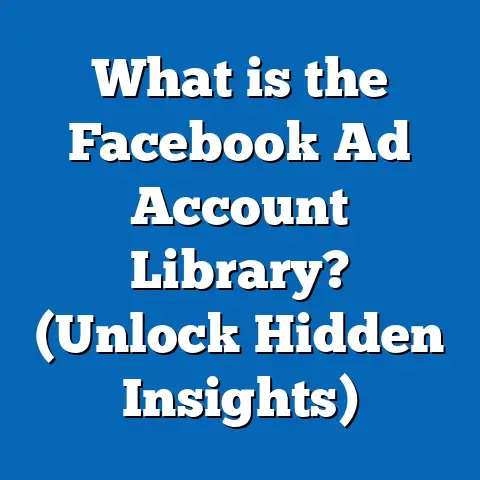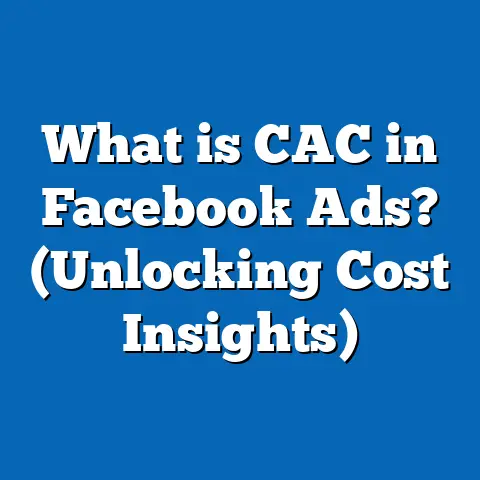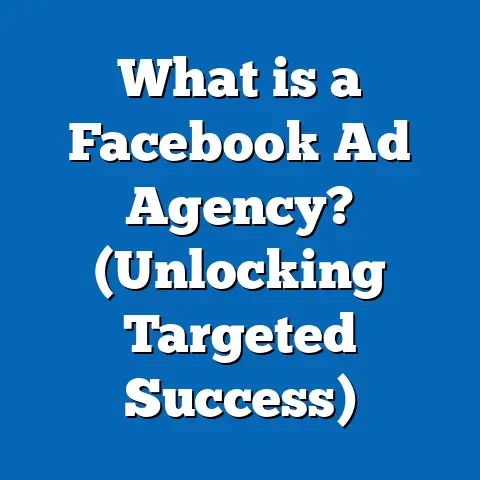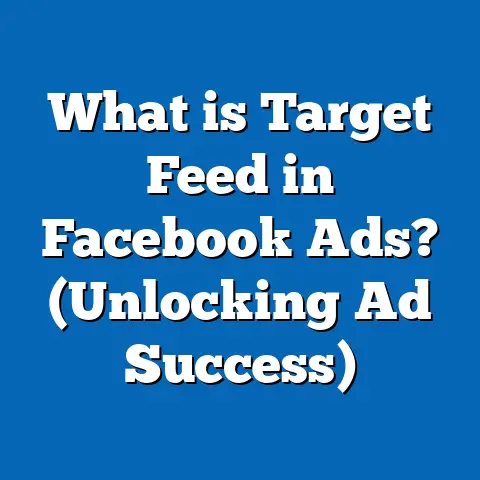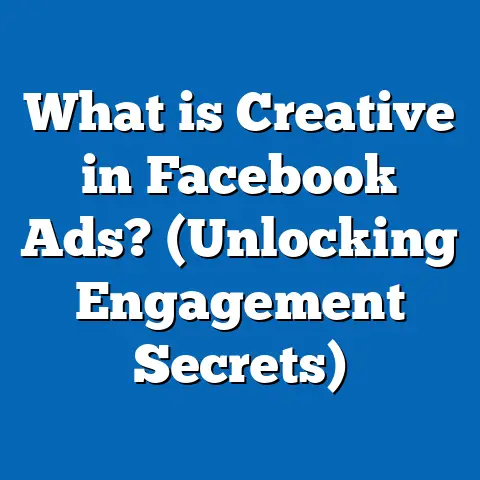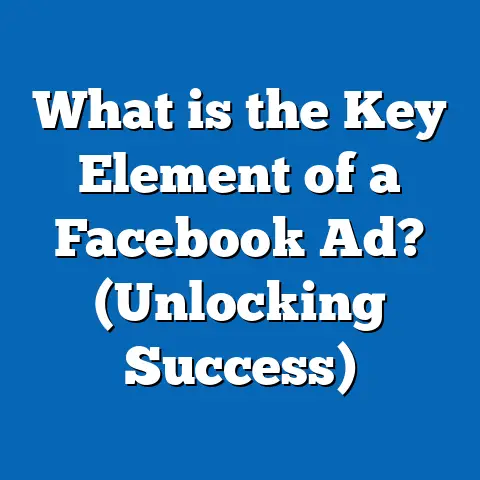What is the Best Facebook Ads Alternative? (Discover Profitable Options)
Introduction: The Warmth of Connection in Digital Advertising
Advertising is more than just delivering messages—it’s about creating meaningful connections that resonate personally with audiences. This warmth, the feeling of relevance and engagement, transforms marketing from noise into conversation. Digital advertising platforms like Facebook Ads have excelled at providing marketers the tools to build these warm connections through precise targeting, diverse ad formats, and massive reach.
Yet, the digital marketing landscape is changing rapidly. Rising advertising costs, increasing competition, privacy regulations, and evolving consumer behavior are prompting marketers to reconsider their reliance on Facebook Ads. For many businesses and marketing professionals, exploring alternatives is no longer just an option; it’s a necessity.
Why Seek Alternatives to Facebook Ads?
Rising Costs and Diminishing Returns
Facebook’s advertising ecosystem has matured into a highly competitive marketplace. Since 2018, average costs per click (CPC) and cost per mille (CPM) have steadily increased. For example:
- The average CPC across industries on Facebook is approximately $0.97. However, verticals such as finance or insurance see CPCs exceeding $3.50.
- The average CPM (cost per 1000 impressions) has risen from around $7 in 2017 to over $11 in 2023.
- According to AdEspresso, competition in auctions has caused click-through rates (CTR) to decline from 0.9% in 2019 to approximately 0.7% in 2023.
These rising costs force marketers to spend more for the same or even diminishing returns, disproportionately impacting small and medium-sized businesses.
Privacy Changes and Tracking Limitations
Apple’s iOS 14 update introduced App Tracking Transparency (ATT), requiring apps to ask users for permission to track their activity across other companies’ apps and websites. This change has directly impacted Facebook’s ability to track user behavior and deliver personalized ads.
- Facebook reported a $10 billion revenue impact in 2022 attributed to iOS privacy changes.
- Conversion tracking accuracy dropped by up to 30% for some advertisers, making performance measurement less reliable.
This has led marketers to question Facebook’s ability to deliver the highly targeted campaigns they once relied on.
Audience Saturation and Ad Fatigue
With over 10 million active advertisers globally as of 2024, Facebook’s ad space is saturated. Users are exposed to repetitive ads leading to fatigue:
- Studies show ad fatigue can reduce CTR by up to 50% after just two weeks of exposure.
- Over-targeting causes audience exhaustion, especially on platforms where users engage with content primarily for social interaction rather than purchase intent.
This saturation creates diminishing returns on ad spend and increases the need for fresh channels.
Diversification: A Hedge Against Platform Risk
Putting all your advertising budget into one platform is risky. Changes in algorithms, policies, or user behavior can cause sudden drops in campaign performance.
Diversifying your marketing mix:
- Spreads risk across platforms.
- Allows testing different audience behaviors.
- Opens doors to untapped markets.
A multi-channel approach has been shown to increase overall campaign ROI by up to 35%.
Key Criteria for Choosing a Facebook Ads Alternative
Selecting an alternative requires careful consideration of several factors:
Audience Reach & Targeting Ability
- Ability to target based on demographics, interests, behaviors.
- Availability of custom audiences or lookalike/similar audiences.
- Access to high-intent users or specific niche segments.
Cost Efficiency
- Average CPCs or CPMs relative to your industry.
- Conversion rates and cost per acquisition (CPA).
- Budget scalability without sacrificing ROI.
Ad Format Variety
- Support for various ad types: text, image, video, carousel, shopping.
- Compatibility with creative assets you can produce efficiently.
Ease of Use
- Intuitive campaign setup interfaces.
- Tools for campaign automation and optimization.
- Availability of learning resources or support.
Analytics & Reporting
- Real-time performance metrics.
- Integration with third-party analytics tools.
- Granular conversion tracking.
Integration Capabilities
- Compatibility with CRM systems.
- API access for custom workflows.
- Ability to integrate with email marketing or retargeting platforms.
Compliance & Privacy
- Adherence to GDPR, CCPA, and other regulations.
- Transparent data handling policies.
- User consent management features.
Top Facebook Ads Alternatives: In-depth Analysis
Let’s explore five of the best alternatives with comprehensive details on each platform’s strengths, weaknesses, features, cost data, case studies, and practical usage advice.
1. Google Ads: The Search Advertising Powerhouse
Overview
Google Ads dominates search engine marketing with unmatched reach—over 92% market share in internet search globally. Unlike Facebook’s interest-based targeting, Google Ads captures users based on search intent—when they actively seek products or services.
Platforms Within Google Ads
- Search Network: Text ads on Google search results and partner sites.
- Display Network: Visual banners across millions of websites.
- YouTube Ads: Video ads reaching over 2 billion logged-in monthly users.
- Shopping Ads: Product listings appearing directly in search results.
- App Campaigns: Promoting mobile apps across Google properties.
Targeting Capabilities
- Keyword targeting with broad match modifiers.
- Location targeting down to zip code level.
- Device targeting: mobile, desktop, tablet.
- Audience targeting through remarketing lists and custom intent audiences.
Pricing & Performance Data
| Metric | Value |
|---|---|
| Average CPC (all industries) | $2.69 |
| Average CTR (search ads) | 3.75% |
| Average conversion rate | ~4% |
| Average ROAS | 200% – varies by sector |
Google Ads generally costs more per click than Facebook but often delivers higher conversion rates due to intent targeting.
Case Study: E-commerce Fitness Brand
An online fitness apparel store redirected 40% of its budget from Facebook Ads into Google Shopping Campaigns. Within three months:
- Sales increased by 40%.
- Cost per acquisition dropped by 15%.
- Return on ad spend (ROAS) improved from 3x to 4.2x.
The shift was attributed to users searching specifically for fitness gear rather than passively seeing ads on Facebook feeds.
Advanced Tips for Google Ads Success
- Use exact match keywords combined with negative keywords to limit irrelevant traffic.
- Leverage audience remarketing combined with search ads for warm leads.
- Optimize landing pages for mobile users since over 60% of searches happen on mobile devices.
2. TikTok Ads: Engaging the Next Generation
Overview
TikTok has exploded in popularity since its international launch in 2018. As of 2025:
- Over one billion monthly active users worldwide.
- Particularly dominant among Gen Z (ages 16–24) and Millennials (25–34).
TikTok’s format is short-form vertical videos offering highly immersive content consumption.
Ad Formats
- In-feed Video Ads: Native ads appearing between organic content.
- Branded Hashtag Challenges: Encourage users to create content around a theme.
- TopView Ads: Auto-play video ads appearing as soon as the app opens.
- Branded Effects: Custom filters or augmented reality experiences.
Targeting Options
- Age, gender, location targeting.
- Interest-based targeting reflecting user interactions.
- Device type targeting (iOS/Android).
- Lookalike audiences based on pixel data or customer lists.
Pricing & Performance Metrics
| Metric | Range/Value |
|---|---|
| Average CPC | $0.10 – $1 |
| Average CTR | 1.3% – 5%, depending on ad type |
| Engagement rates | Up to 20% higher than Instagram |
| Video completion rates | Above 70% |
TikTok ads tend to have lower CPCs but require creative video production investment.
Case Study: Beauty Brand Viral Campaign
A mid-sized beauty brand launched a Branded Hashtag Challenge encouraging users to showcase makeup looks. Results within two months:
- Over 5 million user-generated videos created.
- Product sales increased by 15%.
- Social media followers grew by 23%.
The viral nature of TikTok allowed organic amplification beyond paid reach.
Practical Advice for TikTok Advertising
- Focus on authentic storytelling rather than polished ads.
- Use trending sounds and challenges for relevance.
- Test multiple creatives quickly with TikTok’s split testing tools.
3. LinkedIn Ads: B2B Marketing at Its Best
Overview
LinkedIn is the undisputed leader for professional networking with more than 900 million users globally. It offers unparalleled precision for B2B marketing targeting decision-makers based on job title, company size, seniority, industry, and skills.
Ad Formats
- Sponsored Content: Native ads in feed promoting articles or offers.
- Message Ads (formerly InMail): Personalized messages sent directly into user inboxes.
- Dynamic Ads: Personalized ads leveraging profile data such as job title or company name.
- Lead Gen Forms: Integrated forms that auto-fill user information for effortless lead capture.
Targeting Features
LinkedIn’s unique advantage is professional data:
- Job Titles
- Industries
- Company Names & Sizes
- Seniority Level
- Skills & Groups
- Education & Degrees
Pricing & Performance Benchmarks
| Metric | Typical Range |
|---|---|
| Average CPC | $5 – $9 |
| Cost per Lead (B2B) | $30 – $100+ |
| Conversion rates | Up to 10%, depending on offer |
| Lead quality | Higher than most social platforms |
LinkedIn campaigns tend to be more expensive but generate highly qualified B2B leads with better lifetime value (LTV).
Case Study: SaaS Company Lead Generation
A SaaS provider specializing in HR software switched from Facebook retargeting Ads to LinkedIn Sponsored Content aimed at HR directors:
- Customer acquisition cost decreased by 30%.
- Lead quality improved; sales cycles shortened by two weeks.
- Monthly booked demos increased by 50%.
The professional focus and detailed targeting paid off despite higher upfront CPCs.
4. Pinterest Ads: Inspiring Purchases Through Discovery
Overview
Pinterest functions as a visual discovery platform where users actively seek ideas and inspiration before purchasing products related to fashion, home decor, food, weddings, and DIY projects.
As of mid-2024:
- Pinterest has over 450 million monthly active users.
- Approximately 90% of weekly users use Pinterest for purchase decision-making research.
Ad Types
- Promoted Pins: Blend naturally among organic pins with images or videos.
- Shopping Ads: Direct product listings showing price and availability.
- Video Pins: Engaging video content integrated into feeds.
Targeting Options
Pinterest offers keyword targeting within search results plus interest and demographic targeting:
- Interests (e.g., home improvement)
- Keywords (search-based)
- Demographics: age, gender
- Actalike Audiences (similar users)
Pricing & Performance Insights
| Metric | Value |
|---|---|
| Average CPC | ~$1.50 |
| Average CTR | ~0.20% – slightly lower than Facebook |
| Conversion rate | Up to 2% |
| Return on Ad Spend (ROAS) | Can exceed Facebook depending on category |
Pinterest’s strength is in discovery-driven shopping rather than impulse buys.
Case Study: Home Goods Retailer Holiday Campaign
During the winter holiday season:
- A mid-sized home goods retailer used Pinterest Shopping Ads targeting gift ideas and home decor keywords.
- Website traffic from Pinterest increased by over 300%.
- Conversion rate was twice the average compared to Facebook campaigns run simultaneously.
The retailer credited Pinterest’s “intent-to-discover” audience as key for strong holiday sales growth.
5. Microsoft Advertising (Bing Ads): The Underdog with Untapped Potential
Overview
Microsoft Advertising operates Bing search ads along with Yahoo and AOL properties. Although smaller than Google Ads (~6% desktop search market share in the US), it reaches a demographic often overlooked: older professionals with higher income levels who use desktop search extensively.
Additionally, Microsoft integrates LinkedIn profile data into its advertising platform offering enhanced B2B targeting options unavailable on Google.
Features & Targeting Options
- Keyword targeting similar to Google Search Network.
- Location and device targeting options.
- Unique LinkedIn profile-based targeting (job function, company size).
Cost & Performance Data
| Metric | Value |
|---|---|
| Average CPC | Often 30–50% lower than Google |
| Conversion rate | Comparable or higher than Google |
| Desktop traffic share | ~6% in US |
The lower competition reduces CPCs while reaching affluent users yields better conversion quality in B2B or high-ticket consumer verticals.
- Cost per acquisition fell by 20%.
- Overall leads increased by 25%.
The company attributed success to less competition on Bing and superior LinkedIn-driven targeting.
Comparative Summary Table: Key Metrics at a Glance
| Platform | Best For | Avg CPC* | Audience Size | Strengths | Ideal Use Case |
|---|---|---|---|---|---|
| Google Ads | Intent-driven searches | $2.69 | Billions worldwide | Massive reach; diverse ad types | Direct sales; e-commerce |
| TikTok Ads | Youth engagement | $0.10 – $1 | ~1 billion MAUs | Viral video content | Brand awareness; Gen Z marketing |
| LinkedIn Ads | B2B lead gen | $5 – $9 | ~900 million professionals | Professional targeting | SaaS; services; high-value B2B |
| Pinterest Ads | Visual discovery | ~$1.50 | ~450 million MAUs | Purchase intent discovery | Retail; fashion; home decor |
| Microsoft Advertising | Affluent desktop users | Lower than Google | Smaller but affluent | LinkedIn integration | B2B; niche markets |
*Average CPC varies greatly by industry and campaign specifics.
How to Choose the Right Alternative for Your Business: A Step-by-Step Guide
Choosing an alternative requires a strategic approach:
Step 1: Clarify Your Objectives
Identify what you want from your campaigns:
- Immediate conversions?
- Brand awareness?
- Lead generation?
Different platforms excel at different objectives.
Step 2: Understand Your Audience
Research where your target customers spend time online:
- Younger consumers? Consider TikTok or Pinterest.
- Professionals? LinkedIn or Microsoft Advertising.
Use audience insights tools or surveys if needed.
Step 3: Evaluate Budget Constraints
Calculate your acceptable CPC/CPA based on margins:
- If budget is limited but you want brand awareness, TikTok may be cost-effective.
Step 4: Run Small Pilot Campaigns Test at least two platforms with small budgets:
- Create platform-specific creatives tailored to each channel’s style.
- Set clear KPIs: CTR, conversion rate, ROAS.
- Monitor daily performance carefully.
Step 5: Analyze Data & Optimize Use platform analytics plus third-party tools for deeper insights:
- Identify highest-performing audience segments.
Step 6: Scale & Diversify Gradually increase budget on winning platforms while maintaining some spend diversification across channels.
Advanced Tips for Maximizing Profitability Beyond Facebook Ads
Platform-Specific Creative Strategies
Each platform favors distinct content styles:
| Platform | Creative Style |
|---|---|
| Google Ads | Concise text + compelling CTAs |
| TikTok | Authentic short videos with trends |
| Professional content; thought leadership | |
| High-quality lifestyle images + tutorials | |
| Microsoft | Clear offers + professional tone |
Adapt creatives accordingly for best engagement.
Harness First-party Data & Retargeting
Install pixels or SDKs on your website/app for retargeting warm visitors across platforms—this significantly boosts conversion likelihood.
Use Lookalike Audiences Wisely
Upload customer lists or CRM data to create lookalike audiences expanding reach efficiently without wasting budget on cold traffic.
Continuous Testing & Iteration
Never assume one campaign setup is final—regularly test new creatives, audience segments, bid strategies using A/B tests.
Conclusion: Embrace Broader Horizons for Warm Connections That Convert
Facebook Ads remains a cornerstone of many marketing strategies but are no longer the only option for profitable advertising. Diversifying into platforms like Google Ads, TikTok, LinkedIn, Pinterest, and Microsoft Advertising opens new avenues to connect warmly with your audience based on intent, demographics, behaviors, and context.
Each alternative brings unique strengths tailored for different business models and goals—from capturing high-intent search traffic through Google Ads to sparking viral engagement on TikTok or generating premium B2B leads via LinkedIn.
By understanding these platforms deeply—and integrating them strategically—you can build resilient marketing programs that maximize ROI while delivering meaningful value to customers across their digital journeys.
Next Steps: Crafting Your Multi-platform Advertising Strategy
- Conduct an audit of your current Facebook campaigns identifying strengths and pain points.
- Choose one or two alternative platforms aligned with your audience profile and objectives.
- Develop tailored creatives optimized per platform specifications and user expectations.
- Launch pilot campaigns with closely monitored budgets and defined KPIs.
- Analyze results using platform analytics combined with third-party tools like Google Analytics or Data Studio dashboards.
- Scale successful campaigns while continuously refining messaging and targeting based on ongoing learnings.
- Maintain at least minimal spend diversification across multiple platforms as insurance against future market shifts.
By following this roadmap you will discover profitable alternatives that provide fresh ways to build warm connections with your customers — ensuring sustainable growth well beyond Facebook’s ecosystem.

